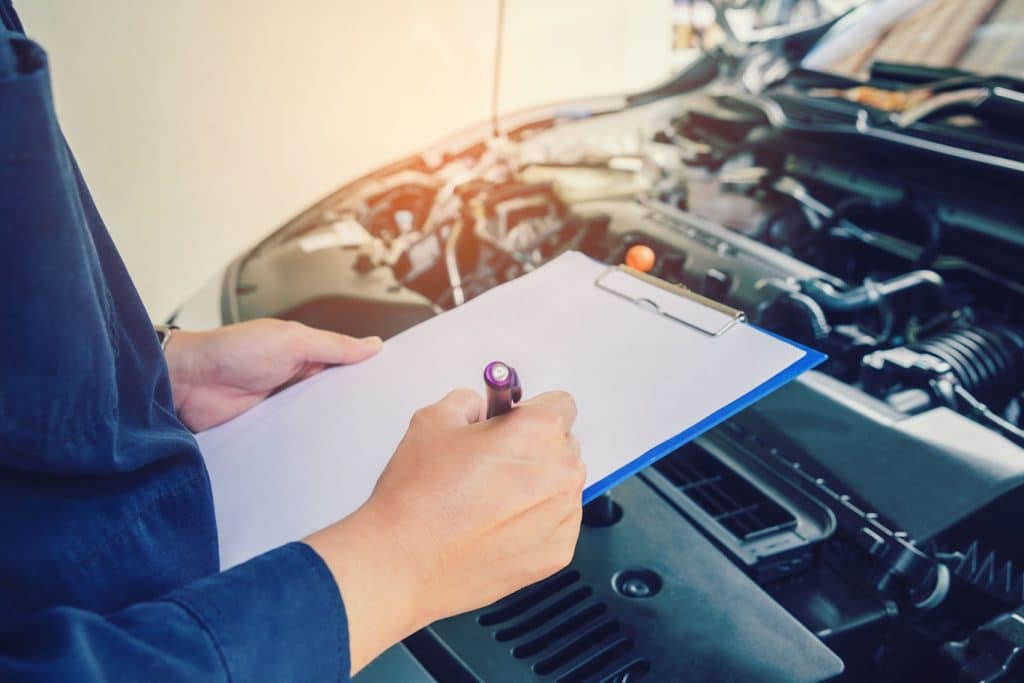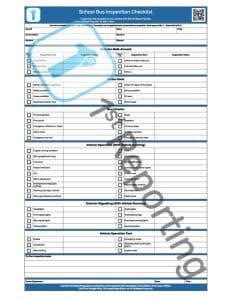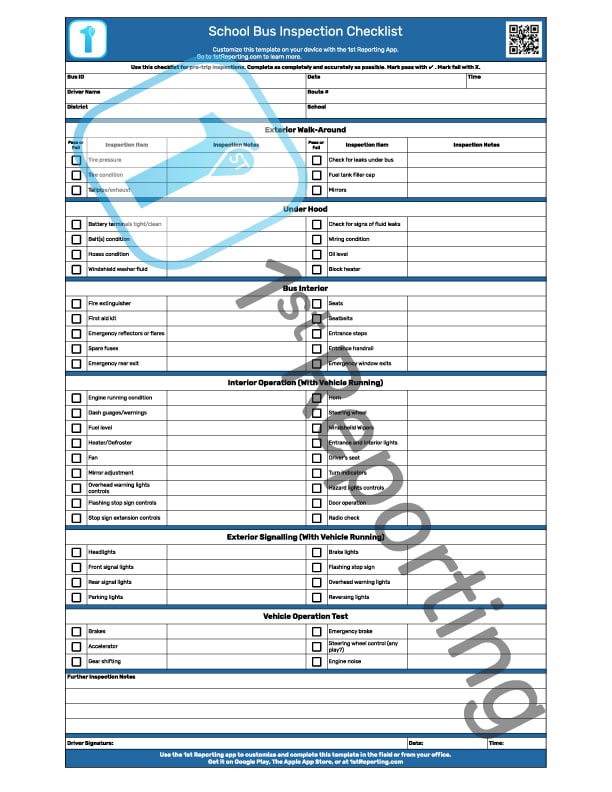School buses are the life-blood of the education system. So, ensuring that you have an effective School Bus Inspection Checklist for your pre-trip inspection is vital to the safe transport of children to their learning destination and back home again.
Bus drivers use a pre-trip School Bus Inspection Checklist to complete daily vehicle safety inspections. These inspections are vital to adhere to the utmost safety standards for our children’s trips to and from school.
We’ve put together an immersive, efficient, and comprehensive pre-trip school bus inspection checklist for you to use with your fleet. We’ll look at the basics of the template, how to use it, and offer some great tips to help you manage your bus fleet and inspections. So, stick with us, let’s get the wheels on this bus rolling, shall we?
Included In The School Bus Inspection Checklist for Pre-Trip Inspections
Like many inspection templates you will find in our free-to-download template library, the School Bus Inspection Checklist comprises various segments for ease of inspection reporting.
Here is the breakdown of the template sections:
- Administrative Information
- Exterior Walk-Around Inspection
- Under Hood Inspection
- Bus Interior Inspection
- Interior Operation (With Vehicle Running)
- Exterior Signalling (With Vehicle Running)
- Vehicle Operation Test Review
Want a little more information about each section? We thought so. Following, you will find a brief breakdown of each segment.
Administrative Information
Any inspection report needs to have information about who performs the inspection and the subject of the assessment. Therefore, you’ll find a place where the driver can record the date, time, name, bus information, and even route and district identifiers.
Exterior Walk-Around Inspection
Most vehicle walk-around inspections should begin with an exterior walk-around. It’s the sensible place to begin. We’ve started at the ground with the tires and work our way up from there. The usual suspects for the exterior inspection are all present, so your drivers won’t miss a beat.
Under Hood Inspection
While already inspecting outside the vehicle, it makes sense to continue to the front of the bus and pop up the engine cover to reveal the heart of the bus’s locomotion center. The engine compartment inspection includes things like checking the battery terminals and connections. It also includes visually inspecting belts, wiring, and hoses and topping up common fluids like oil and windshield washer fluid.
Bus Interior Inspection
With the exterior inspection completed while the vehicle is not yet running, it’s time the driver turns to the interior for review.
Again, we find the usual bus interior inspection items, including emergency equipment such as fire extinguishers and first-aid kits. Similarly, the interior inspection also includes the entrance steps and handrails, emergency exits, seats, and seatbelts, to name a few.
Interior Operation (With Vehicle Running)
Completing the interior inspection, the driver must next turn to check vehicle operation. The vehicle operation check starts with checking the dash lights, warning signals, and further instrumentation. All items mentioned on the School Bus Inspection Checklist maintain a place to note a pass or failing grade and make notes on observations found.
Exterior Signaling (With Vehicle Running)
Similar to the interior operation section of the bus inspection template, we find the exterior signaling section next on the School Bus Inspection Checklist. As the name would suggest, this section focuses on documenting all the vehicle lighting on the bus’s exterior.
Vehicle Operation Test Review
The final aspect of any comprehensive pre-trip bus inspection is reviewing the vehicle’s operation. A driver will operate the vehicle at ultra-slow speeds for a moment to ascertain the working condition of things like the brakes, steering, and engine operation. The section also rightfully includes observations of engine noise and even gear shifting comments.
How To Use The Pre-Trip School Bus Inspection Checklist

When documenting bus pre-trip inspections, a downloadable template can come in handy. It is especially true if your agency or organization has specific requirements that you must include in the inspection report.
To best use the pre-trip school bus inspection checklist, follow these simple steps:
- Download the free template – School Bus Inspection Checklist
- Make enough copies to suit your fleet and the number of days this batch of reports will cover.
- Dispense the template to your bus drivers and instruct them on its use.
- Set up a filing system to maintain copies of the inspection reports.
As you can see, the template is simple to use. The sections are clear and concise, and there’s even a brief set of template directions for completion right at the top of the page above the administrative information section.
Suggested Manual Edits
Each state and province may maintain local or regional legislation regarding bus inspections. So, we anticipate you will require minor changes or edits on our downloadable template.
Some states require specific language for the school bus inspection checklist. You can include these details in the ‘Notes’ section at the bottom of the template, so your drivers know exactly what to have in their reports.
By making this type of edit, you are providing a uniform format that will help your drivers meet the requirements of their state or department. However, if you don’t wish to make these kinds of edits mid-year, simply set up a custom pre-trip inspection sheet for this purpose. Naturally, we’re going to recommend our customizable digital solution – the 1st Reporting App.
In any case, we recommend reviewing all edits with each driver before they leave on their route. Instruct them to print two copies of the inspection report – one for their records and one to include with the daily report.
Some drivers may be used to including a section or passenger behavior, which is an excellent way to build camaraderie between your adult staff members. However, you will want to review any added information included in this section with your transportation department before passing anything along to the school or organization.
An Unofficial Pre-Trip Inspection
In addition to the official pre-trip inspection, you might consider an additional or ‘unofficial’ assessment to ensure your drivers learn to use the form correctly. It is an excellent way for a driver to take a few minutes in his spare time to make sure all seats are in place and the bus is clean inside. If you notice an area that needs attention, go ahead and inform your drivers. Nothing is worse than spending time on a task only to find your driver didn’t do it correctly or entirely in the first place.
At the end of each day, make sure your drivers take time to review their ‘unofficial’ inspection. It is the time to catch anything they may have missed before leaving on their route and help coach them to write more valuable reports.
Things You Need To Know About School Bus Pre-Trip Inspections
The first thing drivers or bus fleet managers typically ask about pre-trip inspections is legally required. Well, here’s the thing about that – in most countries, bus drivers must perform and document a pre-trip vehicle inspection.
Considering the nature of a bus driver’s job – to ferry children from home to school and back again en masse, pre-trip inspections legal requirements shouldn’t even come into one’s mind. Keeping kids safe during transport via a robust vehicle safety program should be a standard everywhere. With that in mind, we recommend performing a pre-trip safety inspection whether legally obligated to do so or not.
What The Law Says About Bus Inspections

Disclaimer: This article does not constitute legal advice. Although we have done our best to ensure the accuracy of the information provided, laws can change at any time. Please check with local authorities to ensure you comply with local legislation.
United States of America
According to the Code of Federal Regulations in the United States, several mandatory inspections are required for motor carriers such as buses.
CFR 49B, Chapter III, Subchapter B, Part 396 of the Code of Federal Regulations clearly states the requirements of inspection, repair, and maintenance of motor carriers. Here are the highlights regarding assessments derived from the code that you need to be aware of:
- Part 396.1 – Summary Points Of Interest:
- Drivers must be knowledgeable of and comply with the regulations regarding vehicle inspections. Ergo, training is most definitely required, and you should have documentation of such. 49 CFR 396.1(a)
- Part 396.3 – Summary Points Of Interest:
- You must maintain parts and accessories in safe and proper order at all times. 49 CFR 396.3(a)(1)
- Pushout windows and vehicle emergency exits (as well as exit marking lights) must have a full inspection every 90 days at the minimum. 49 CFR 396.3(a)(2)
- You must maintain vehicle inspection records for a minimum period of 30 days. Therefore, a comprehensive filing system is needed. For ease of data collection and document retention, you should consider using a digital inspection app like the 1st Reporting app. You will find it much easier than printed hard copies (as long as your drivers use a smart device like a phone or tablet, that is). 49 CFR 396.3(b)
These required records must include:
- Vehicle ID with company number
- Serial number
- Year of manufacture
- Tire size
- Owner of the vehicle (if leased, rented, or otherwise not-owned directly)
- Inspection and maintenance logs indicate the due date and nature of the inspection or maintenance.
- Record of inspections, repairs, and maintenance. These must also indicate the date and nature of service.
- Record of testing the push-out windows and other emergency exits on the bus. Similarly, these records must also include the accompanying emergency lighting systems test.
You must maintain the above records at your place of business for no less than one year. If a bus leaves your fleet, you must keep the records for six months after the bus has departed your ownership. 49 CFR 396.3(c)
Canada
In Canada, the law is clear about pre-trip inspections of work vehicles, including buses. Any driver of a vehicle owned and operated by a company, whether for profit or not, must perform a pre-trip vehicle inspection. Failure to do so can result in hefty fines.
Regulation 199/07 of the Highway Traffic Act covers the requirements for commercial motor vehicle inspections in Canada.
The regulation clearly states that buses and any other vehicle used for transporting children must have a pre-trip inspection completed no more than 24 hours before using the vehicle.
United Kingdom
The Health and Safety Executive in the UK has similar rules to the US and Canada regarding vehicles used for work (including buses). The HSE clearly states:
“By law, every employer must make sure that work equipment is maintained in an efficient state, in efficient working order and in good repair.”
The HSE also states:
“Employers may find it helpful to give drivers a list of daily checks to sign off for their vehicles.
An incident reporting system is essential to enable employers to meet their legal obligations to report some accidents.”
We won’t go into more detail, but the idea is the same. As a company that owns and operates a fleet of buses, you must complete safety inspections of any vehicle (including buses) used by the company and its staff.
Solutions For Document Retention For Pre-Trip Vehicle Inspections

Are you interested in a versatile, cloud-based inspection and reporting platform? Look no further!
Our app, 1st Reporting, is perfect for using smart devices for inspections, audits, and report retention. Plus, we offer a library of standard reporting templates perfect for any business or organization.
The app allows users to access a library of standard reporting templates from vehicle inspections to workplace injury incident procedures. Plus, you can customize not only templates but automated notifications too! So the app is the perfect solution for replacing outdated paper forms and filing cabinets with new mobile form automation technology.





